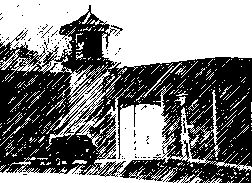Solitary confinement in a bare cell with one meal a day was introduced as a punishment for breaking the rules. But solitary had the disadvantage of removing prisoners from the labor force necessary to support the institution, Physical punishment, which had a less disruptive effect on inmate labor, was authorized. Soon, the very punishments that prisons were supposed to have eliminated were widely used within the prisons themselves, and the whip was the most common. Water "cures," stocks, "stretchers," and the sweatboxes were all widely used in American prisons well into the 20th century. By the 20th century, the old concept of "reformation" had largely disappeared, and most prison administrators viewed the goal of prisons as simply to keep prisoners securely in custody. Indeed, the warden's first assistant, who was responsible for the day-to-day operation of the prison, was known as the "principal keeper."

|
|
Sing Sing Prison.
|
In New York, as one prison became overcrowded, another was built, always on the Auburn principle. In 1825, Sing Sing was built along the Hudson River north of New York City by a hundred inmates from Auburn who were transported down the Hudson by boat, shackled in irons. When the swelling prison population threatened the silent program and the individual cell policy, additional cell blocks were added to Auburn and Sing Sing. In 1844, the construction of Clinton Prison was authorized.
The construction of all these prisons followed the same basic plan. In fact, prison construction in the United States did not change until well into the 20th century, and even then variations were usually minor and often short-lived. From the beginning the American prison has been a maximum security institution.
As new Auburns were built throughout the country, the severity of the prison routine became the subject of criticism by a new generation of penal reformers. In 1870, the National Prison Association, at its founding meeting in Cincinnati, reminded the authorities that "reformation, not vindictive suffering should be the purpose of penal treatment of prisoners."

|
|
Ohio governor and later U.S. President Rutherford B. Hayes served as first president of the National Prison Association that eventually became the American Correctional Association.
|
At the turn of the century, New York made efforts to actually implement some of the specific proposals of the Cincinnati Congress of 1870. The first such effort was Elmira Reformatory, opened in 1876 for young first offenders. Built on the same architectural principle as Auburn, however, it soon proved to be only another prison in the style of Auburn, but with younger inmates -- a maximum security reformatory. In 1911, Great Meadow, a new prison without a wall around it, was built for young first offenders. The striped uniforms and the silent lockstep were discontinued. The vale of silence continued in actual practice in most institutions, but at Great Meadow movies were presented to the inmates once every two weeks. The dining area provided small tables with chairs in order that the young inmates could dine in a more natural atmosphere than that provided by immovable tables and stools in the other prisons.
Due to the overcrowding elsewhere, however, it was not many years before Great Meadow began receiving second offenders and other first offenders who were deemed by the authorities to require close supervision. Discipline tightened at Great Meadow; enforcement of silence appeared in the routine; and a prison factory, like those at Auburn, Sing Sing and Clinton, was started.

|
|
Elmira Reformatory.
|
By 1928, a wall had been erected around the once medium security prison of the Great Meadow, and it was added to the list of adult main maximum security prisons of the state.
The architecture of prisons had become a self-engendering style. The major improvements in the construction of prisons were the introduction of escape-proof cells and unbreakable toilets and wash basins. This escalating process of constructing ever more secure prisons reached its pinnacle in 1931, when the most secure, escape-proof prison ever built opened in the little upstate village of Attica, New York. With such dedication poured into its construction, Attica was, at the time, the most expensive prison ever built. Construction had begun in 1929 and continued into the early years of the Depression. Over one hundred years had passed since inmates from Auburn had gone to work to build Sing Sing. In the spring of 1930, the scene was repeated; inmates from Auburn were transported to Attica to assist in construction.
In the late 1920s there had occurred the first "wave" or widespread outbreak of prison riots in this country. [9]

|
|
Clinton State Prison, Dannamora.
|
In July 1929, some 1,600 inmates of Clinton Prison rioted in protest of overcrowding there; three inmates were killed when the state put down the uprising. In the same year, Auburn Prison exploded when a trusty threw acid into a guard's face, overpowered him, and secured the keys to the prison arsenal. Guns were passed out to several inmates and a general riot ensued in which four inmates escaped. six shops were burned, the assistant warden was killed, and the prison was wracked before the prisoners were subdued by rifles, machine guns, and tear gas. Then, as now, New York's immediate response to the uprisings in its prisons was the appointment of official investigators and commissions to determine the causes of the sudden uprisings.
Attica State Prison in New York was to be the solution to the [then] recent problem of prison uprisings and the response to the commissions that investigated them. When Attica opened, it was widely hailed as the ultimate prison.

|
|
Attica State Prison.
|
Its wall alone, enclosing 55 acres, was 30 feet high, extended 12 feet into the ground, and cost $1,275,000 to erect. The prison contained four separated cellblocks, each of which could house some five hundred men in individual cells. The total cost of the prison eventually reached the sum of "approximately $9,000,000."[10] The New York Times, reporting on the recent riots and the new prison under construction, stated on January 22, 1930, Whatever may be the outcome of that agitation, the immediate and practical answer to the convict revolts has been the new Attica prison.
Neither Green Haven nor any other prison since Auburn, however, has created the interest that Attica did when it was built. Shortly before it opened, Attica was hailed in the following article, which appeared in the New York Times on August 2, 1931:
|
ATTICA PRISON TO BE CONVICT'S PARADISE
Condemned by the Wickersham Commission for its maintenance of Auburn and Clinton prisons, New York State will have an answer to charges of inhuman penal conditions when the New York State Prison opens at Attica within the next few months with its full quota of 2,000 convicts. Said to be the last word in modern prison construction, the new unit in the State's penal system will do away with such traditions as convict bunks, mess hall lockstep, bull pens, and even locks and keys. In their places will be beds with springs and mattresses, a cafeteria with food under glass, recreation rooms and an automatic signal system by which convicts will notify guards of their presence in their cells. Doors will be operated by compressed air, sunlight will stream into cells and every prisoner will have an individual radio. [11]
|
Perhaps because of the Depression economy, perhaps for other reasons as well, no Attica inmate has ever seen the institution described above. When Attica opened, there was no cafeteria with food under glass, no recreation room, no automatic signal system, and no sunlight streaming into the cells. There was, in fact, nothing but another huge, foreboding prison. With the unprecedented emphasis on security visible in every brick and every door, this "last word in modern prison construction," far from doing away with locks and keys made them the focal point around which all life revolved.
When Attica opened, over 130 years had passed since Auburn Prison was built; the population of New York State had changed vastly; the entire social structure of the nation had been dramatically altered; new laws and social conditions had altered the very nature of crime itself; theories of human behavior had been radically modified by the developing social sciences. In fact, everything had changed -- everything but the prisons. They were still built in the silent congregate style of Auburn.
|





